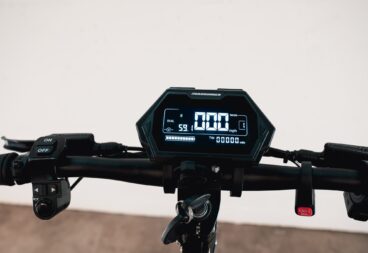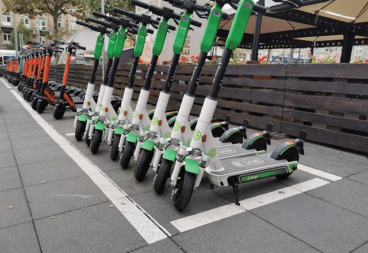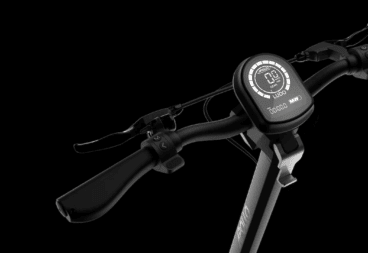This guide explains everything you need to know about electric scooter brakes — the most important part of your electric scooter. You’ll learn which braking systems are the most effective and about the most common types: disc, drum, foot, regenerative, and electronic brakes.
Electric Scooter Brakes
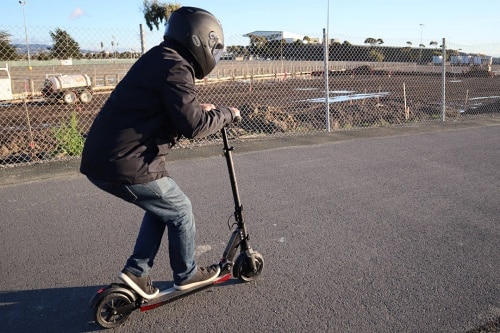
Brakes are the most important safety feature of an electric scooter. Modern electric scooters pack powerful motors and can go in excess of 20 mph! Although you might expect to get injured in a collision with vehicles, the reality is most falls are accidents that don’t involve anyone else. Having a scooter with a good set of brakes may be the only difference between a close call and trip to the hospital.
Your brakes determine stopping distance, physical effort to activate, durability, and performance in wet conditions. Electric scooters will have at least one braking system, and many come with more than one type. We prefer scooters with more than one braking system, in case one fails.
Brake Type Comparison
Comparison of different brake types. Performance is how strong they are in al conditions. Maintenance refers to ease of repair and adjustment. Feel / Usability refers to how easy they are to use, how they feel, and how progressive/linear they are.
| Type | Performance | Maintenance | Feel / Usability |
| Disc, Hydraulic | |||
| Disc, Semi-hydraulic | |||
| Disc, Cable | |||
| Drum | |||
| Foot | |||
| Regenerative | |||
| Electronic |
Brake Systems: Front and Rear
Some electric scooters have brakes only on the front or rear wheel. This is less desirable than having an independent brake on each wheel. Scooters with only single-wheel braking won’t stop as quickly and offer less redundancy than those with dual brakes. In wet conditions, where traction is worse, scooters with only a single brake are more prone to slipping because all the stopping force is coming from one rather than two wheels. However, most scooters come equipped with at least one mechanical brake (typically in the rear) and a front electronic brake
Brake Performance: Mechanical vs. Electronic
How well your brakes perform starts with the type of braking system(s) equipped on your scooter, and we’ve done the research so you’ll know which brakes have been the most effective in our real-world road tests.
Mechanical brakes include disc brakes, drum brakes, and foot brakes. The ESG team found disc brakes to be the best performing, followed pretty closely by drum brakes. The typical 15 mph stopping distance for mechanical systems is 20 feet, with the absolute best stopping power being under 10 feet.
Foot, regenerative, and electronic brakes are all poor-performing braking systems for various reasons (deeper details below). Although foot brakes are mechanically controlled, they do not perform as effectively as disc or drum brakes. The typical 15 mph stopping distance using an electronic brake alone is 30 to 40 feet — more than the length of a squash or badminton court, for reference. This is also equivalent to the length of 2 to 3 cars, so imagine the force and injury you could suffer if you can’t stop quickly enough.
Disc brakes are the best and safest type of electric scooter brake and come ESG recommended. They provide strong braking power in both wet and dry conditions. Additionally, they are lightweight, reliable, and easy to adjust. You will find disc brakes on quality electric scooters in nearly every price range and exclusively on high-performance electric scooters.
Types of Brakes
There are two main brake categories: mechanical and electronic. In order of effectiveness, electric scooter brake types include: disc brakes, drum brakes, foot brakes, regenerative brakes, and electronic brakes.
Disc Brakes
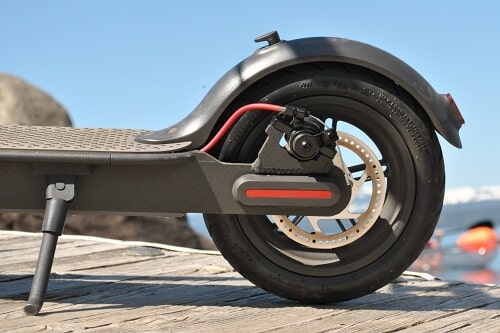
How disc brakes work A metal disc called a rotor is attached to and spins with the electric scooter’s wheel. The most common design for the control for brakes is a hand lever, similar to what you would find on a traditional bicycle. When you pull on the brake lever, it activates a component called a caliper which surrounds part of the rotor. The caliper pinches the spinning rotor with brake pads, causing friction which slows the wheel.
Disc brakes come in three flavors:
- Hydraulic
- Semi-hydraulic
- Mechanical
Hydraulic Disc Brakes
Fully hydraulic disc brakes use fluid-filled (hydraulic) lines to control activation of the brake calipers. When you squeeze down on the brake lever, it increases the pressure in the hydraulic lines which are connected to brake calipers. The increased pressure in the brake calipers causes a piston to move, pinching the rotor. Fully hydraulic disc brakes are the best type of disc brake. The hydraulic activation gives you the best control over your braking. As you squeeze down the brake lever, braking is strong and consistent. This contrasts with cable-activated mechanical disc brakes which may not feel as linear and consistent due to friction in the cables.
Semi-hydraulic Disc Brakes
Semi hydraulic disc brakes are similar to fully hydraulic brakes, but instead of having a hydraulic line that runs from lever to the caliper, they use a cable. The cable runs from the brake lever to the caliper and moves a hydraulic piston when activated. They have fairly strong and consistent braking power.
Cable-controlled Disc Brakes
Mechanical disc brakes, the most common type of disc brake, use a brake cable to activate the caliper. Most mechanical cable-actuated disc brakes are activated by a brake lever. Pulling on it shortens the brake cable, which is connected to the brake caliper. The brake caliper mechanically transmits force to cause the brake pads to pinch the rotor. You might feel more resistance from the cables on mechanical disc brakes over hydraulic disc brakes, as there’s often more friction.
Advantages of Disc Brakes
- Excellent braking power
- Perform well in both wet and dry conditions
- Lightweight braking system
- Easy to adjust and maintain
- Excellent braking control, especially with hydraulic disc brakes
Disadvantages of Disc Brakes
- May require occasional adjustments and maintenance
- Disc brakes may increase the overall cost of the scooter
- Poor, rough riding conditions may diminish performance
- Poorer quality disc brakes are susceptible to rotor damage*
*This is a common problem seen on shared electric scooters, which are often abused or in disrepair.
Drum Brakes
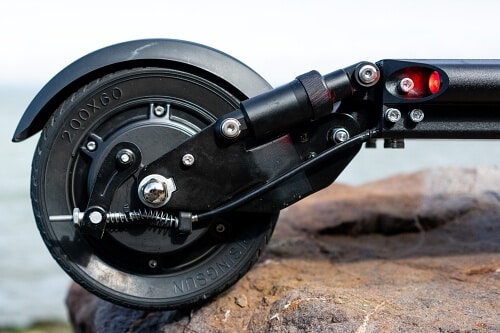
How drum brakes work Drum brakes are enclosed inside the wheel hub and have pads that push outward against the braking surface, causing friction that slows the wheel. The brake is fully enclosed, protecting it from the environment. Its enclosure is a benefit but also a downside; as drum brakes overheat they become less effective. Although it’s not as likely to be a problem with a scooter as with cars (given speed and load), it’s something that can affect how well drum brakes perform.
As with disc brakes, drum brakes are activated by cable-actuated hand levers, ordinarily with the left-hand lever operating the front brakes and the right-hand lever operating the back. They are almost as effective as disc brakes, generally require less maintenance, but are more complex to work on.
Advantages of Drum Brakes
- Generally low maintenance
- Consistent performance in wet conditions
- Moderate braking performance
- Completely enclosed in wheel hub
Disadvantages of Drum Brakes
- Heavier braking system
- Complicated to disassemble or repair
- Lower performance than disc brakes
- Poor performance when overheated
How Do Drum Brakes Work?
Drum brakes are enclosed inside the wheel hub and have pads that push outward against the braking surface, causing friction that slows the wheel. The brake is fully enclosed, protecting it from the environment.
Foot Brakes
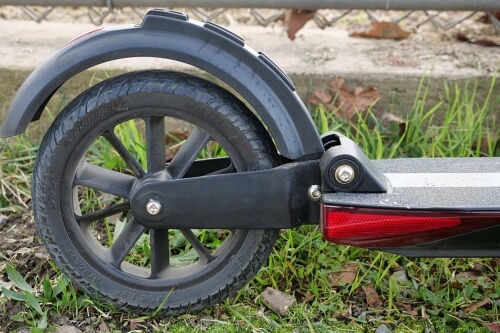
How foot brakes work Foot brakes are a hinged fender that is pushed into the rear tire, generating friction that slows the wheel. You activate them by pushing down on the fender with your heel. You’re pressing down on the rear tire to slow the scooter — which means you have to move your rear foot off the deck to brake or keep your rear foot at the ready. Although that sounds simple enough, slight movements can cause you to lose balance, especially on scooters with smaller tires, which is the last thing you want to do when braking.
Advantages of Foot Brakes
- No maintenance
- Lightweight braking system
- Simple design to use
Disadvantages of Foot Brakes
- Poor performance
- Even worse performing in wet conditions
- Foot activated not as effective as hand-activated brakes
- Requires specific (uncomfortable) riding position
Regenerative Brakes
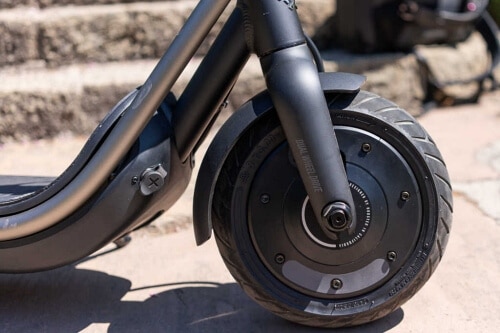
How regenerative brakes work Regenerative brakes are activated by a switch which electrically couples the motor into the charging system, creating resistance to motor rotation. The idea is that you can recover energy during braking and thereby extend range. On some scooters the regen is activated as soon as you let off the throttle. On others, it is activated exclusively by the brake lever or a dedicated button. Almost no electric scooters come with regenerative braking only, as it’s not an effective enough system standalone.
Although regenerative braking works in theory, it’s not a as strong as mechanical brakes and marginally improves range. Many electric scooter companies overstate how much extra range you’ll get from electric scooter brakes. According to our own analysis, electric scooter brakes aren’t very helpful for extending range.
Advantages of Regenerative Brakes
- No added weight or maintenance
- Minor energy recovery
Disadvantages of Regenerative Brakes
- Poor braking performance
- May not work when the battery is fully charged
- Some regenerative braking systems are poorly implemented and prone to total failure
Electronic Brakes
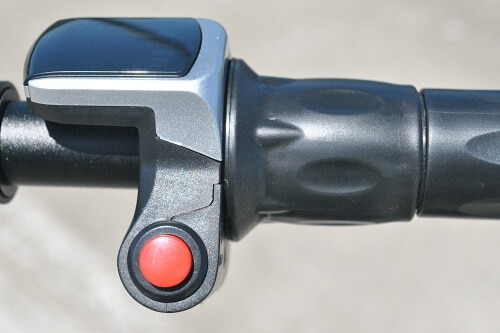
How electronic brakes work Electronic brakes function in nearly identical manner to regenerative brakes, except they do not help recharge the battery. They are activated by a switch that shorts the terminals of the motor, creating resistance to motor rotation. Electronic brakes are activated in a couple of ways: push button or brake levers. Some scooters come with a push button along the handlebars to engage electronic brakes, while other models require a slight pull-and-release on the brake levers. You will feel the scooter decelerate slightly as electronic brakes engage.
Advantages of Electronic Brakes
- No added weight or maintenance.
Disadvantages of Electronic Brakes
- Poor braking performance
- Some electronic braking systems are poorly implemented and prone to failure
Summary
Brakes are essential for your safety, so it’s very important to understand how your brakes work and inspect them periodically between rides. Before launching into traffic for the first time, it’s a good idea to familiarize yourself with how accelerating and braking feel, and learning how to stop quickly but safely.
If you are shopping for an electric scooter, pay attention to what brakes it has. We always recommend scooters with at least two braking systems for redundancy.
Check out our current ESG Editor’s pick of the best electric scooters on the market!
Frequently Asked Questions
Can you replace scooter brakes? If so, is it safe for me to do it or do I need a professional?
You can replace disc brakes and foot brakes as their components are mostly exposed. It is very difficult to replace drum brakes, as they are housed inside the hub of the scooter wheel. You cannot replace regenerative or electronic brakes as they are built into the electrical systems of the scooters.
If I don’t feel comfortable doing it myself how should I go about replacing or repairing the brakes?
If you have a warranty, your scooter brakes may be covered for repair or replacement. The distributor may have you return the scooter to them for repair or send you parts to perform the replacement yourself. This varies by brand, warranty, and distributor. You can also look for a local PEV shop or bicycle shop in your neighborhood, as they may be able to provide maintenance.
